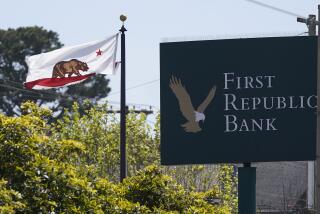A Good Cash Flow for S&L; Bailouts
- Share via
Fortunes have been made in this country in many ways, but one that has consistently worked is taking advantage of government subsidies of one sort or another. In the late 19th Century, the federal government gave railroads the land that extended a mile on each side of the tracks to induce them to build railroads to the West Coast. This helped create immense fortunes for Western railroad magnates such as Stanford, Huntington and Hopkins.
More recently, the oil industry received huge benefits from government. Real estate is another area that has been showered with government help, much to the benefit of landowners, developers, builders and speculators. Tax deductibility of mortgage interest reduced financing costs for individuals, and mortgage rates in earlier years were held down by regulation of the savings industry.
Now, in the era of deregulation, free markets and federal budget squeezes, the benefits from government help have disappeared from most industries. But there still is at least one major area where the government is not only willing to help, but also to allow entrepreneurs to play a “heads-I-win, tails-the-government-loses” game. This area is the nation’s financially troubled banks and savings and loans.
The Federal Deposit Insurance Corp. has $18 billion in surplus funds but is worried that any substantial reduction in that surplus caused by paying off insured depositors in failed commercial banks could create a financial panic. Despite the high likelihood that Congress would provide whatever funds are necessary, depositors in other banks might worry that there would not be enough funds left to pay them if their banks failed, and as a result, could make an anticipatory run on those banks.
The FDIC’s concern is well founded, since an array of failing banks could cause a big drain on its funds. In Texas alone, problem banks may cost the FDIC $6 billion to $8 billion.
The FDIC seems willing to do almost anything to keep troubled banks afloat, and the bigger the potential disaster, the more willing it is. The zeal to keep big failing banks afloat is seen clearly in the FDIC’s agreement with the group led by A. Robert Abboud to take over Texas’ First City Bancorp.
The FDIC has put in $1 billion under very generous terms, and it will wait as long as 10 years to get its guaranteed replacement of $100 million of that assistance. First City plans to spin off its $1.72 billion in nonperforming loans and foreclosed real estate into a “bad” bank and to use the collection proceeds, estimated at only $1.02 billion to pay off the FDIC, leaving other creditors unpaid.
The Abboud group is providing $500 million, mostly in the form of junk bonds and preferred stock sold to outside investors. And while common stockholders have been almost entirely wiped out--and most holders of First City’s bonds have been paid 35 cents to 45 cents on the dollar--the bailout promises an immediate 15% on the investors’ new money. Also, the new management can, upon inspection, reject any loan or other asset it doesn’t like and throw it out of its “good” bank into the “bad” bank, where it becomes the FDIC’s responsibility.
Clearly, the Abboud group will make a fortune if it can operate the clean “good” bank successfully. If it cannot, the FDIC becomes an ever bigger loser than it already is. Heads Abboud wins, tails the FDIC loses.
The Federal Savings and Loan Insurance Corp. (FSLIC), which insures depositors in savings and loan firms and other thrift institutions, is in even more precarious straits than the FDIC. Its liabilities--including obligations to depositors in failed thrift institutions, which it continues to allow to operate because it doesn’t have the funds to shut them down and pay off depositors--exceeded its assets at the end of 1987 by $11.6 billion, almost double the $6.3-billion shortfall at the end of 1986.
Furthermore, failed thrifts will probably pile up at least another $10 billion in losses, and therefore FSLIC obligations to depositors, in 1988. (On June 21, the government announced that the savings and loan industry collectively had a net loss of $3.8 billion in the first quarter of the year.) Clearly, the $10.8-billion rescue package for the thrift industry that Congress approved last year is insufficient. Estimates are that $35 billion or more will be needed to clean up the mess.
Therefore, the FSLIC is even more willing than the FDIC to accommodate outside rescuers. Former U.S. Treasury Secretary William E. Simon and his group have taken over several failed savings and loans. And now the Robert M. Bass Group has signed an agreement with the Federal Home Loan Bank Board, the FSLIC’s parent, to negotiate the takeover of American Savings, the deeply troubled thrift unit of Financial Corp. of America. Terms are yet to be worked out, but the plan calls for the Bass Group to infuse some new capital in return for substantial federal aid.
Because of losses, bad loans and foreclosed real estate over the past four years, American savings’ capital is $1.3 billion short of regulatory requirements. Its assets include about $5 billion in troubled loans and foreclosed real estate.
I believe that government-sponsored rescues of failing banks and thrifts will become a growing and profitable business in the years ahead. It certainly meets the time-honored criteria for ways to make big money through farsightedness, brains, courage, cleverness, clairvoyance, skill, daring, savvy, luck--and enough government money to virtually guarantee that one can’t fail.
More to Read
Inside the business of entertainment
The Wide Shot brings you news, analysis and insights on everything from streaming wars to production — and what it all means for the future.
You may occasionally receive promotional content from the Los Angeles Times.










